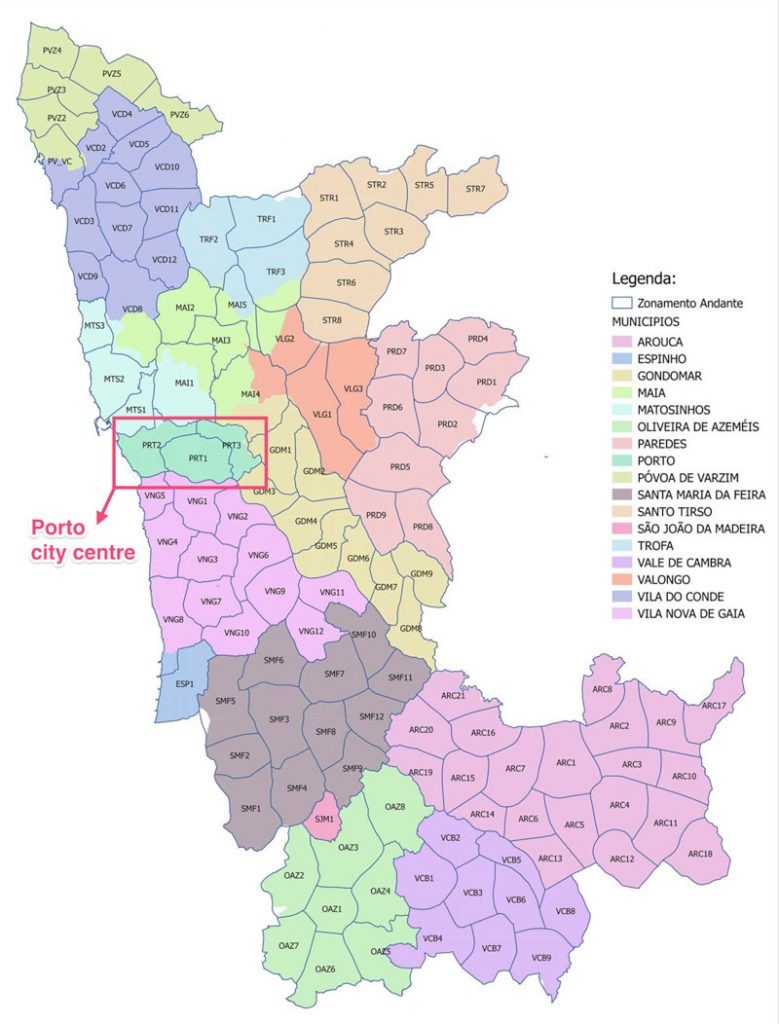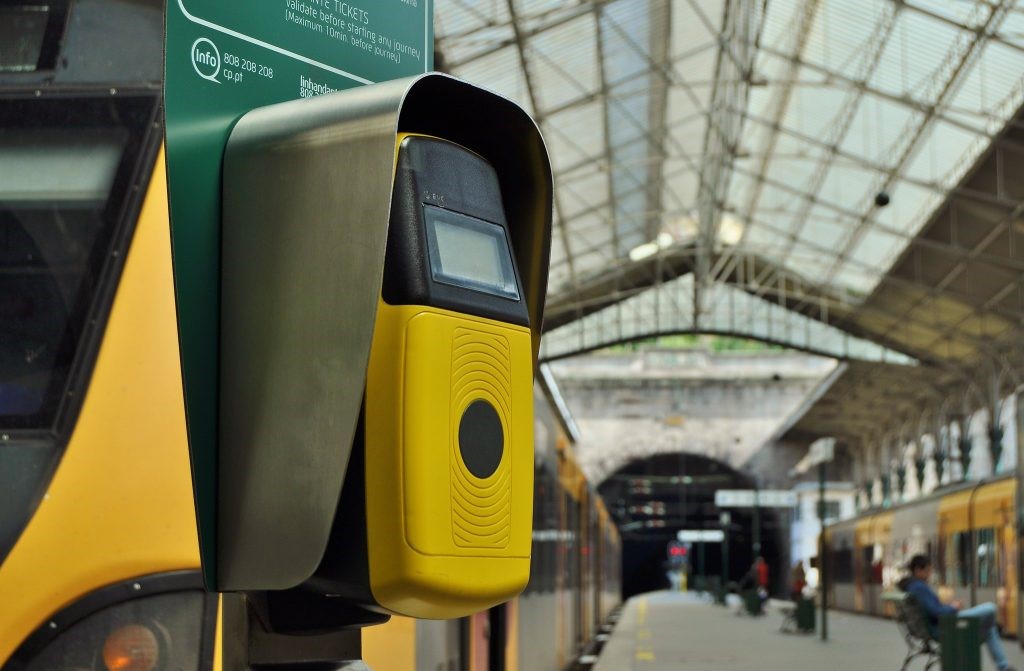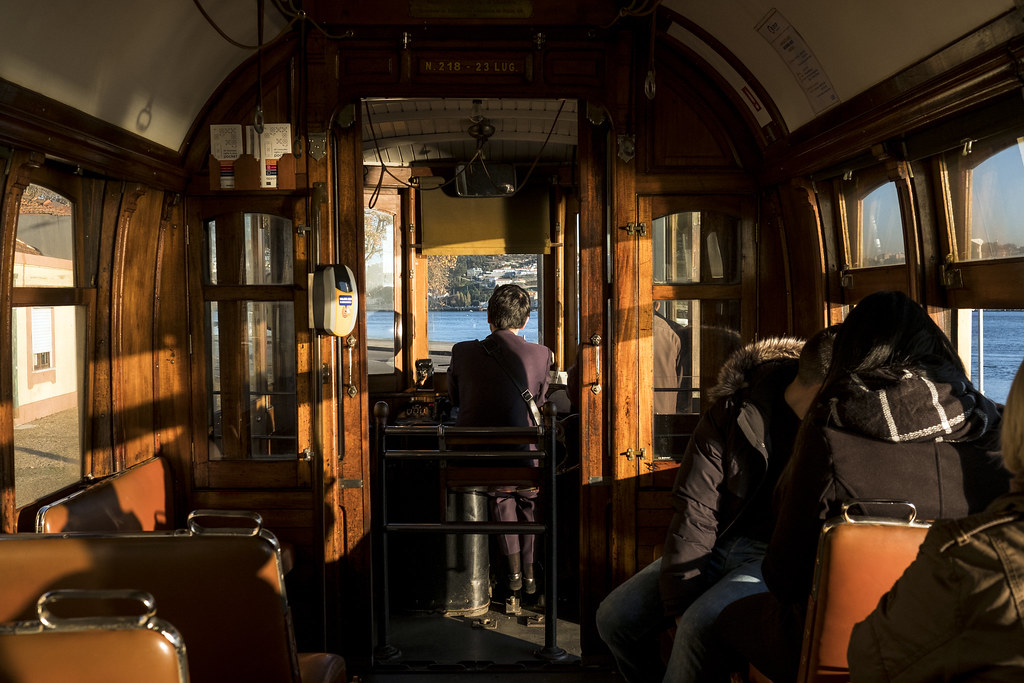Porto is a city in the north of Portugal and is the second most important in the country, after Lisbon, the capital. There is a lot to do in Porto, from history, culture, museums, attractions, monuments, churches, castles, beaches, and nightlife.
Traveling to the city is easy and getting from point A to point B is usually a brief trek. We will describe how to get to the city from the airport, as well as how to get around the city ones you are there.

From OPO airport to downtown Porto
Metro
You can take the metro line E from the airport into the city. A ride to one of the city’s central stations takes around 30 minutes. Buy the ticket and validate it before entering the train. Price for a single journey is 2€, plus the cost of the ANDANTE ticket (if you don’t have one).You must validate a charged ANDANTE always before beginning your travel, when you change line or transport. Both occasional and signature ANDANTE cards must always be validated. You can validate it, at most, with 10 minutes of antecedence before beginning the trip. Not doing it will provide you a fine of 95€.
Public buses
Besides the metro, the airport is served by three public bus lines that will take you to Cordoaria’s Garden in the centre of Porto, and to Saint John’s Hospital, in the Paranhos neighbourhood.
- 601 – AEROPORTO (Via MAR Shopping) – CORDOARIA
- 602 – AEROPORTO (Via Padrão Moreira) – CORDOARIA
- 604 – AEROPORTO (VIA Crestins) – HOSPITAL S.JOÃO
Itineraries and departure times can be found on the STCP website.
ANDANTE Ticket
ANDANTE ticket is a card that can be (re)charged with travel titles and can be used in the different public transport operators (STCP, CP and Metro) in the Porto Metropolitan area.
All ANDANTE are rechargeable. Do not throw them away after your journey has ended.
If you use the blue ANDANTE, you can recharge it with how many titles you want to and how many times you want to.
If you use the ANDANTE Gold, you can travel freely inside the zones previously selected. You can use that same card to recharge your pass every month.
The Blue ANDANTE costs 0,60€ and the ANDANTE Gold 6,00€.
You can buy ANDANTE here:
- Andante Shops (in several stations of Metro do Porto and CP)
- Automatic Machines (in all the stations of Metro do Porto)
- Service posts STCP
- Ticket sellers CP with ANDANTE sale
- Mobility Centre
- Payshop Agents and Post Offices
- Road Private Operators Terminals
Private shuttles
Several private companies offer direct shuttle services from the airport to different areas of Porto and neighbouring cities. More information about these options can be found on the airport website.
Taxis and ride-sharing services
Taxis can be found right outside the arrivals area. There are also 4 ride-sharing services operating around the Porto area:
- Uber
- Bolt
- Kapten
- Cabify
How to get around the city
Porto’s public transportation system is operated by STCP (Sociedade de Transportes Colectivos do Porto) and includes the metro, suburban train lines, buses, and historic trams.
To use the system, you will need to purchase an Andante card from one of the metro stations or from Andante stores.
By Bus
Besides Porto’s tourist bus, the city’s normal bus system is very good and works perfectly. It is one of the most traditional ways of getting around in the city, and even with the arrival of the metro, it continues to be used by many people, from the youngest to the oldest. The buses run daily from 6am to 9pm. Tickets can be bought directly from the driver or at newsstands and tobacconists (it is cheaper to buy a set of tickets).
You can pay for journeys either using an Andante card or in person to the driver for a fixed cost of €2.
Most bus stops have timetables and itineraries, but online services like Google Maps or Moovit will also come in handy when planning your journey.
The closest bus stop to the WCEU venue is Palácio (Stop IDs: PAL 2, PAL 3, PAL 4 and PAL 5). This is served by the following services running on both sides of the road:
- 200 – CAST. QUEIJO – BOLHÃO
- 201 – VISO – ALIADOS
- 207 – MERCADO DA FOZ-CAMPANHÃ
- 208 – ALDOAR – ALIADOS
- 303 – CIRCULAR PRAÇA DA LIBERDADE – CONSTITUIÇÃO
- 501 – MATOSINHOS (PRAIA) – ALIADOS
- 507 – LEÇA (Via MAR Shopping) – CORDOARIA
- 601 – AEROPORTO (Via MAR Shopping) – CORDOARIA
- 12M – STO.OVÍDIO – AV.ALIADOS (night bus)
- 13M – MATOSINHOS (MERCADO) – AV.ALIADOS (night bus)
You can also check timetables and route maps at the STCP website.
By Metro
The subway is the newest means of transportation in the city. It also works as a streetcar, in Portugal, since they can ride on the surface.
Porto Metro has six lines that run from A to F covering a good part of Porto and neighboring cities (Matosinhos, Vila Nova de Gaia, Vila do Conde, Maia, Gondomar, Póvoa do Varzim).
Lines A, B, C, E and F run on the same axis, while line D runs on a North-South axis crossing the center of the city.
It runs from 6am to 1am.
A curiosity is that there is no turnstile or any kind of barrier. There are only some poles (not preventing the passage) where you pass the “andante card”, which is the ticket, and ready, you can continue the walk to the subway. Many people think that it is easy to get around this scheme, but many guards go through the subway checking whether the tickets have been validated. If they catch someone who entered without paying, they will certainly charge a good fine.
Most metro stations will have a table that will help you work out the number of zones your planned journey will cross. On buses, the loudspeaker announcing the stations will indicate when the bus is moving into a new zone.
A ride to Aeroporto station (Airport) would require a Z4 ticket, while a Z2 ticket is enough to travel to Aliados station.

STCP offers a discount when purchasing more than 10 journeys at once. This ends up being more cost-effective than paying for one trip at a time, but it’s worth noting that you’re not allowed to top up the same card with different types of tickets. For instance, you cannot have a Z2 ticket and a Z4 ticket loaded onto the same Andante card.
An Andante card can only be used by the person who bought it. If you’re travelling with other people, each person will need their own Andante card.
Ticket Validation
There are no turnstiles on the network, but you will need to validate your Andante card at the start of your trip. This can be done by simply tapping the card on one of these totems:
It is not necessary to validate your card at the end of your journey.

To get to the Super Bock Arena – Pavilhão Rosa Mota, the most convenient metro station is Casa da Música. This is on the A, B, C, E and F lines. From there, you can either take a 1.5km walk, or catch one of the following buses to the venue:
- 201 – VISO – ALIADOS
- 303 – CIRCULAR PRAÇA DA LIBERDADE – CONSTITUIÇÃO
- 501 – MATOSINHOS (PRAIA) – ALIADOS
- 507 – LEÇA (Via MAR Shopping) – CORDOARIA
- 601 – AEROPORTO (Via MAR Shopping) – CORDOARIA
Another station that is close to the venue is Carolina Michaelis, which also sits on the A, B, C, E and F lines. From there, you will be able to either walk 1.5km to the event, or take one of the following buses, which will drop you about 400m away from the arena:
By Train
Called “comboio” in Portugal, the train is another very traditional way of getting around, especially to visit other cities. The main train stations are São Bento Station and Campanhã Station. See our specific article about train travel in Porto, where we give the main information.
Buses are the main way to get around Porto in areas not covered by the metro.
Suburban trains
Trains leaving from the São Bento and Campanhã train stations can take you to other areas in the Porto district, and other major cities in northern Portugal, like Braga and Guimarães.
Prices vary depending on the destination. Tickets for all lines can be purchased in person at stations, and some routes are also sold through the CP website or apps.
Tourist tram
While the tram is not widely used anymore, STCP still has a few lines running across Porto, mostly aimed at tourists. The tickets are more expensive than the rest of the network and can be purchased before boarding. For more information, please visit the STCP website.
By Taxi
Taxis in Porto are identified by their teal and black colour scheme and can be found all over the city, especially in the city centre. Fares start at €2.50 and increase depending on the time and distance of the journey. There are also extra charges for carrying luggage and pre-scheduled pick ups.
A ride from the airport to downtown Porto costs around €20-25, and trips within the city centre typically cost around €5-10.
Ride-sharing services
There are 4 ride-sharing services operating in the Porto area:
- Uber
- Bolt
- Kapten
- Cabify
By Car
Renting a car in Porto is very easy and a very worthwhile option. Portugal is a very small country, compared to other big countries in the world. The trip from north to south of the country can take only 6 hours, so it is very easy to visit the main cities and places in Portugal. Another advantage, even if you are not going to travel the country and stay in only one city, is the convenience and freedom of schedules. If you go shopping in Porto, for example, there is nothing better than having your own vehicle to put all the bags in.
Great tip to find the fastest and cheapest route
A very good tip for you to see all the transportation options from one city to another, and be able to choose the cheapest one, is to use this route finder.
It is a great site that shows all the transportation options between one city and another. It searches for all the airplane, train and bus options, and you can buy the best and cheapest one for your trip.
The prices are cheaper than anywhere else, and the site is a leader in this service in Europe, showing only companies that are reliable and consolidated there.
In any case, for more information about timetables and stops of the trains and buses, you can visit the Porto Public Transport Company website where you will find all necessary information.

